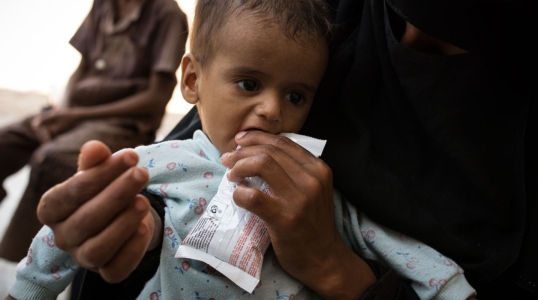While Famine Looms, War in Ukraine Reduced the Percentage of Fully-Funded
Hunger Programs in 2022, According to Action Against Hunger
Only 47% of hunger funding needs through the UN humanitarian system are met, leaving a hunger funding gap of 53%, according to the Action Against Hunger 2023 Hunger Funding Gap report. Released today, the analysis also found that countries experiencing the worst hunger crises received less hunger funding (by the percentage of appeals filled) than countries with lower rates of hunger.
While overall funding rose slightly in 2022, support was spread even thinner as needs grew. In 2022, only 3% of hunger program needs were fully funded and the majority (65%) of appeals were not even fulfilled to the halfway point. In 2021, 7% of hunger programs were fully funded and 57% of were not funded halfway. Zero nutrition-related appeals were fully funded in 2022, down from 15% in 2021.
The Action Against Hunger 2023 Hunger Funding Gap report was issued shortly before the one-year anniversary of the war in Ukraine, which increased the cost of food, fertilizer and energy. One in three households in Ukraine are estimated to be food insecure, and the war also has had far-reaching ripple effects. Approximately 828 million people — one in ten worldwide — are undernourished and as many as 50 million people in 45 countries are on the verge of famine.
“Before the war, all of Somalia’s wheat imports came from Russia or Ukraine. By raising prices for food and fertilizer, the war in Ukraine is killing Somali children, too,” said Ahmed Khalif, Country Director for Action Against Hunger in Somalia. “Our team looked at the percentage of funder-related appeals fulfilled by the global community and found that countries with lower hunger rates received more funding than countries experiencing the worst hunger crises. I see the impact, as the needs here keep growing every day.”
For the report, Action Against Hunger identified 13 countries that experienced “crisis” levels of hunger or worse in 2021 and analyzed how much funding those countries subsequently received, both for ongoing and emergency hunger-related programs in 2022. The analysis draws on food insecurity data from 2021 to show what funding decisions are made after donors see where hunger is greatest. This approach controls for the potential that hunger levels would be lower in countries that receive more funding.
“Hunger is a complex issue and funding is just part of what it will take to end hunger in our lifetimes. Yet, after working for more than 40 years and in 50 countries, we know that closing the hunger funding gap is a critical step,” said Eric Bebernitz, Director of External Relations, Action Against Hunger. “While some donors gave more last year, needs rose even faster than support from the global community. It’s short-sighted, since according to a USAID study, each dollar invested in resilience reduces later humanitarian spending by up to $3.”
The report is the result of Action Against Hunger’s analysis of the United Nations Office for the Coordination of Humanitarian Affairs (OCHA) Humanitarian Response Plan funding data, as well as the Integrated Food Security Phase Classification (IPC) Population Tracking Tool.





